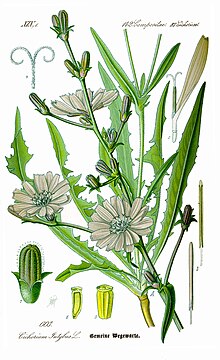| Common chicory | |
|---|---|

| |
| Blue-flowered form | |
| Scientific classification | |
| Kingdom: | Plantae |
| Clade: | Tracheophytes |
| Clade: | Angiosperms |
| Clade: | Eudicots |
| Clade: | Asterids |
| Order: | Asterales |
| Family: | Asteraceae |
| Genus: | Cichorium |
| Species: | C. intybus
|
| Binomial name | |
| Cichorium intybus | |
| Synonyms[1][2] | |
|
Synonymy
| |

Common chicory (Cichorium intybus)[3] is a somewhat woody, perennial herbaceous plant of the family Asteraceae, usually with bright blue flowers, rarely white or pink. Native to Europe, it has been introduced to the Americas and Australia.[4]
Many varieties are cultivated for salad leaves, chicons (blanched buds), or roots (var. sativum), which are baked, ground, and used as a coffee substitute and food additive. In the 21st century, inulin, an extract from chicory root, has been used in food manufacturing as a sweetener and source of dietary fiber. Chicory is also grown as a forage crop for livestock.
- ^ "Cichorium intybus L. synonyms". Tropicos.org. Missouri Botanical Garden. Retrieved 23 March 2014.
- ^ "Cichorium intybus L." The Plant List. 2013. Retrieved 23 March 2014.
- ^ "Cichorium intybus". FAO - Food and Agriculture Organization of the UN. Archived from the original on 2013-05-23. Retrieved 2013-12-16.
- ^ "Cichorium intybus L." Plants of the World Online. Retrieved 18 February 2023.